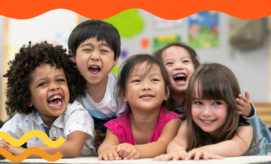The topic of inclusion has become an increasing focus of discussion among early learning professionals. Recent articles highlight the benefits of inclusive practices, as powerful tools for creating classrooms that are welcoming and representative of our diverse communities. Viewing our classrooms through a lens of inclusion enables us to create spaces that are more accessible, accommodating, and welcoming to children with diverse needs, abilities, and backgrounds.
Why is Inclusion Important in ECE?
Inclusion is not a new concept for early childhood educators, who have long recognized that it is critical for every early childhood program to be a place that welcomes and includes all children.
Elizabeth Knudten, an educator and director, shares that, “In early childhood, every classroom is an inclusive classroom, whether you’re talking about children with abilities or just children that have had different life experiences up until this point. You look at your environment differently — and how is the environment accessible to every child, and how is your environment set up so that every child is getting exactly what they need?”
According to a joint statement on early childhood inclusion from The National Association for the Education of Young Children (NAEYC) and The Division for Early Childhood (DEC), “the defining features of inclusion that can be used to identify high quality early childhood programs and services are access, participation, and supports.”
An inclusive environment will look like a place where…
-
Everyone belongs
-
Everyone is welcome
-
The environment is accessible
-
The needs of all children are met
-
There is partnership between parents and educators
Who Does Inclusion Benefit?
Everyone! Inclusion benefits children with and children without disabilities. Barb Van Haren, Director of Special Education for the Wisconsin Department of Public Instruction, explains, “We know that young children need a variety of rich experiences with all of their peers, and we also know that not only children with, but children without disabilities benefit from an inclusive environment.”
In inclusive classrooms, children have opportunities to both teach and learn from each other. When children with different abilities are in a classroom together, it gives them an opportunity to challenge themselves and try new things. Children also get to form friendships and relationships with children who are different from themselves, which allows them to learn first-hand the value of diversity within their community.
Inclusion is also enriching for educators. Like children, educators learn from observation; and in inclusive classrooms, they have an opportunity to observe teachers, therapists, and other team members utilizing different techniques and tools to create an environment in which every child can learn. This creates a space that encourages teachers to bounce ideas off one another and value the creativity of their peers.
In an inclusive program, everyone benefits from a mission of welcoming and celebrating diversity. Educators, children, and parents can all thrive when they are part of a rich community that includes different cultures, backgrounds, abilities, and needs.
If you’re looking for more information on inclusion, you might enjoy this article from the Good2Know Network archives: The Basics of Inclusion in Early Learning.






